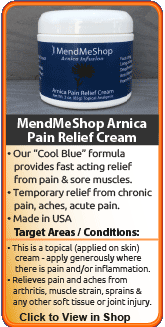Plantar FasciitisPlantar Fasciitis Symptoms
Plantar Fasciitis Causes/Risk Factors
Conservative Home Treatment Options for Plantar FasciitisThe trick with healing plantar fasciitis and beating it once and for all is getting the plantar fascia to heal quickly, with minimal scar tissue formation. Even with optimum healing, there is always less elasticity in a plantar fascia after an injury, which may cause the fascia to hurt during daily activities and exercise. However, if you heal your injury efficiently and quickly, your chance of re-injury later on is much lower than average. Allowing your plantar fascia to rest is always recommended following injury. Avoid all activities that may have caused the injury or irritation and begin Cold Compress or Ice Pack treatments if there is swelling or inflammation. The plantar fascia is difficult to rest completely as it is essential for daily activities. During your recovery, you will probably have to modify and/or eliminate any activities that cause pain or discomfort in your plantar fascia until your pain and inflammation settle. Conservative Treatment Step 1: Reduce The Initial InflammationInflammation is the body's natural response to an immediate soft tissue injury and is a normal part of the healing process - helping to reduce tissue infection in the early stages of injury. Swelling, pain, heat sensation, redness, and loss of function are the main symptoms experienced. The combination of rest, topical pain relief cream and minor amounts of cold is the gold standard in medicine for minimizing tissue damage and reducing inflammation after injury or activity. It serves as a critical bridge into the next phase of the healing process. Conservative Treatment Step 2: Enhance Blood Flow to the Injured Plantar LigamentOnce the inflammation in your plantar fascia has been reduced, nourishing and strengthening the tissue in the plantar fascia and surrounding area is recommended. The use of Circulatory Boost will induce a heat effect, deep in your soft tissue, including the plantar fascia. When heat is applied, soft tissue will elongate, become more flexibile, and blood circultion will increase for a short term (during and after your treatment (Chapter 9 of "Therapeutic Heat and Cold", 4th edition. amazon.com link - Ed. Justus F. Lehmann, M.D., Williams, and Wilkin). These benefits can be quite substantial in helping reduce risk of reinjury, while also boosting the ability of the body to heal this soft tissue injury. The plantar fascia receives a limited blood supply and this greatly reduces its natural ability to heal itself. By treating your plantar fascia with Circulation Boost via the Plantar TShellz Wrap®, you can increase your body's blood supply to the foot and increase your body's natural healing power. In addition, the fresh blood flow whisks away dead tissue and toxins that have built up from injured soft tissue. Conservative Treatment Step 3: Recognize That Healing is a ProcessWith dedication, the right tools, and the right information - you will achieve your goal of a sustainable recovery. A combination approach of cold, heat treatments, and functional movements will make it happen much more quickly. Healing takes a comprehensive approach and will differ from person to person. If you have questions, we welcome you to call our office toll-free at 1-866-237-9608 (Continental US), or Internationally at +1-705-532-1671. The best option we came across in our research to accomplish faster healing of soft tissue injuries in the plantar is the Plantar TShellz Wrap®. Use of this device results in a significant increase in blood flow to injured ligaments located in the underside of the foot- all in a non-invasive manner. Pain and Anti-inflammatory (NSAIDs - Non-steroidal anti-inflammatory drugs) can be used if required to help manage your pain. However, these aren't recommended for long term use, as they can cause gastrointestinal difficulties and increase the risk of cardiovascular disease. The use of cold packs and Circulatory Boost in conjunction with NSAIDs can greatly improve the effect of this medication and can help to heal quicker. The more diligent you are with your treatment and rehabilitation, the faster you will see successful results! With these simple therapies you will notice incredible results in your knee. These conservative treatments are, in our opinion, highly effective, pain-free ways to treat plantar fasciitis at home. Recovery time can be lengthy depending on your situation so full commitment to treatment (6 weeks to 6 months or longer) is crucial. Avoidance of aggravating activities (any activity that involves repeated, impact of your heel on a hard surface such as jumping) and activity modification (pursuing less strenuous, weight bearing routines such as water exercises or biking) is recommended. Remember: We recommend that you consult your doctor and/or physiotherapist before using any of our outstanding products, to make sure they're right for you and your condition. Learn More About Achilles Injuries & TreatmentsI want to learn more about Achilles Surgery & Post-Surgery Recovery I want to learn more about Circulation Boost I want to learn more about Ice & Heat: Which Is Better For The Achilles? I want to learn more about Stretching for the Achilles FREE SHIPPING ON ALL PRODUCTS CURRENTLY ENABLED |

Achilles Tendon Facts There are over 250,000 achilles tendon injuries each year in the US. Achilles tendon ruptures are common in people between the ages of 30 and 50. In runners, too rapid an increase in mileage, hill training without proper strengthening, and recent or inadequate changes to running gear can cause injuries to the Achilles tendon. Achilles tendonitis accounts for an estimated 11% of running injuries. 3-5% of athletes are forced to leave their sports career due to Achilles tendon overuse injuries that go untreated. Medications mask the pain but do very little in the healing of Achilles tendonitis. A fully ruptured tendon REQUIRES surgery. It will not heal on its own. Achilles tendonitis and Achilles tendinitis are the same thing. Continually using your Achilles tendon while it is injured will lead to a more serious and/or chronic injury.        |


